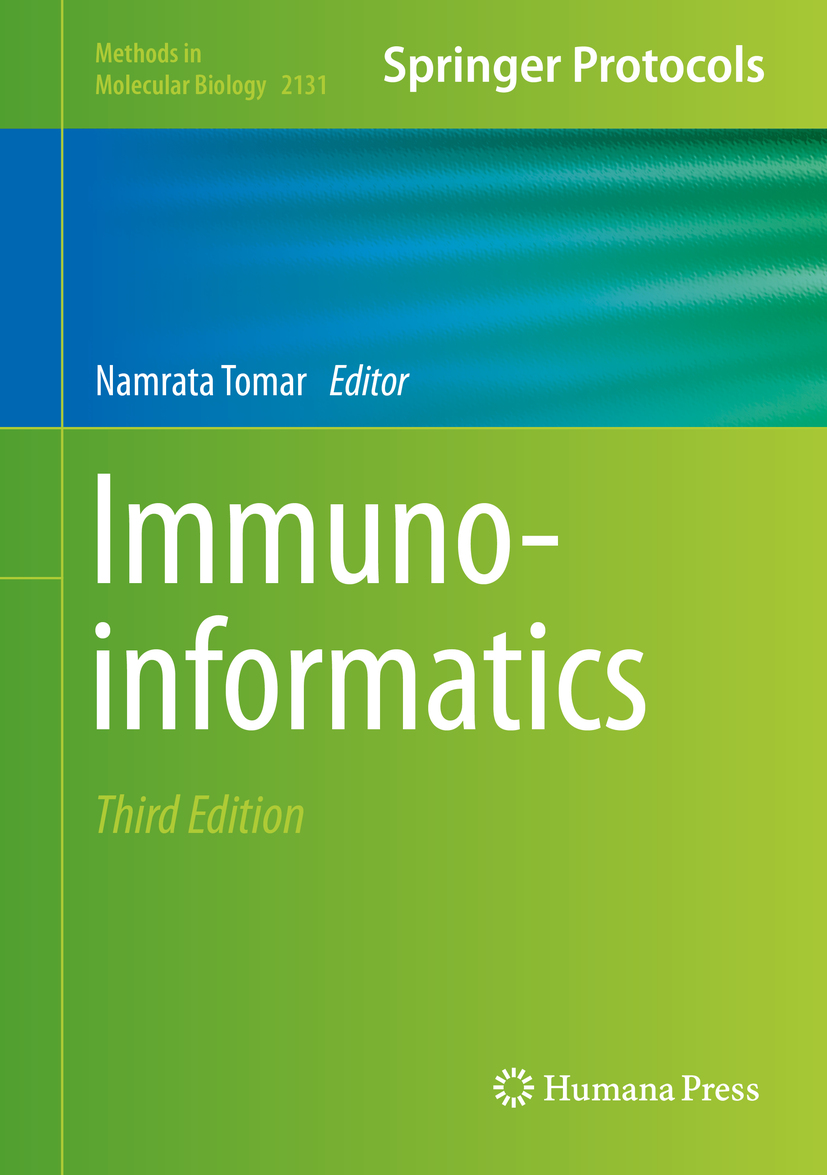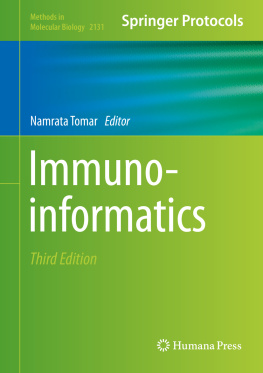Namrata Tomar - Immunoinformatics
Here you can read online Namrata Tomar - Immunoinformatics full text of the book (entire story) in english for free. Download pdf and epub, get meaning, cover and reviews about this ebook. year: 2020, publisher: Springer US, genre: Home and family. Description of the work, (preface) as well as reviews are available. Best literature library LitArk.com created for fans of good reading and offers a wide selection of genres:
Romance novel
Science fiction
Adventure
Detective
Science
History
Home and family
Prose
Art
Politics
Computer
Non-fiction
Religion
Business
Children
Humor
Choose a favorite category and find really read worthwhile books. Enjoy immersion in the world of imagination, feel the emotions of the characters or learn something new for yourself, make an fascinating discovery.
- Book:Immunoinformatics
- Author:
- Publisher:Springer US
- Genre:
- Year:2020
- Rating:5 / 5
- Favourites:Add to favourites
- Your mark:
- 100
- 1
- 2
- 3
- 4
- 5
Immunoinformatics: summary, description and annotation
We offer to read an annotation, description, summary or preface (depends on what the author of the book "Immunoinformatics" wrote himself). If you haven't found the necessary information about the book — write in the comments, we will try to find it.
Immunoinformatics — read online for free the complete book (whole text) full work
Below is the text of the book, divided by pages. System saving the place of the last page read, allows you to conveniently read the book "Immunoinformatics" online for free, without having to search again every time where you left off. Put a bookmark, and you can go to the page where you finished reading at any time.
Font size:
Interval:
Bookmark:

For further volumes: http://www.springer.com/series/7651
For over 35 years, biological scientists have come to rely on the research protocols and methodologies in the critically acclaimedMethods in Molecular Biologyseries. The series was the first to introduce the step-by-step protocols approach that has become the standard in all biomedical protocol publishing. Each protocol is provided in readily-reproducible step-by-step fashion, opening with an introductory overview, a list of the materials and reagents needed to complete the experiment, and followed by a detailed procedure that is supported with a helpful notes section offering tips and tricks of the trade as well as troubleshooting advice. These hallmark features were introduced by series editor Dr. John Walker and constitute the key ingredient in each and every volume of theMethods in Molecular Biologyseries. Tested and trusted, comprehensive and reliable, all protocols from the series are indexed in PubMed.

This Humana imprint is published by the registered company Springer Science+Business Media, LLC, part of Springer Nature.
The registered company address is: 1 New York Plaza, New York, NY 10004, U.S.A.
The immune system is very complex and consists of numerous cell types, molecular pathways, and signals, which help a host system to distinguish between normal, healthy cells and unhealthy cells. All immune cell types have a specific role and ways of recognizing potentially harmful foreign bodies. To get the diverse details of an immune network, a researcher may optimize immune responses for a specific issue that may range from minor infections to cancer. This requires implementing data mining, statistics, and machine learning approaches to convert high-throughput immune data into meaningful insights. In simpler terms,Immunoinformaticsincorporates the application of bioinformatics methods, mathematical models, and statistical techniques for the study of immune systems biology. The development of immunoinformatics tools, databases, and models involves computer scientists and modeling experts working closely with immunologists in a multidisciplinary team. Modeling and computational approaches have been widely applied to solve the problems in immunology as in quantifying the data generated in laboratory experiments and extracting meaningful biological information on its kinetics. To state the value of computational tools and models in immunology research, we need a variety of immune system-related databases, prediction software and modeling tools, informatics, and computational infrastructure for connecting computer modeling and wet-lab experimentation, as well as data analytics and visualization.
This book consists of 23 chapters that cover diverse immunoinformatics research topics. It involves tools and databases of potential epitope prediction, HLA gene analysis, MHC characterizing, in silico vaccine design, mathematical modeling of host-pathogen interactions, and network analysis of immune system data.
Chapterintroduces a reverse vaccinology approach and its advantages and applications. It basically searches through genomic sequences to predict antigens that have a capacity to be used as potential vaccine candidates. It describes required web tools, databases, and software to predict potential epitopes for vaccine development.
Chapterintroduces a peptide-based vaccine approach to design an in silico vaccine against Zika virus.
Chapterfocuses on high-definition genomic analysis of human leukocyte antigen (HLA) genes that encode for major histocompatibility complex (MHC) proteins. The genotyping of HLA alleles was done through whole genome sequencing data, whole exome sequencing data, or targeting sequence of HLA genes by using next-generation sequencing technology.
Chapterdescribes detailed steps for a computational vaccine design for MERS-CoV infections. It mostly makes use of IEDB software to predict the suitable MERS-CoV epitope vaccine.
Chapterintroduces an alignment-independent platform for allergenicity prediction. It utilizes three modular servers to assess the allergenicity of a randomly selected allergenic protein and demonstrates a protocol for fast and reliable in silico prediction.
Chapterreviews the methodology used for computational identification of B and T cell epitopes against enterotoxigenicEscherichia coli,along with other databases of epitopes and analysis tools for T cell and B cell epitope prediction and vaccine design.
Chapterintroduces immunoinformatics and molecular docking methods to screen potential vaccine candidates for Leptospira, which is responsible for Leptospirosis, a zoonotic disease.
Chaptertakes into account a residue-centric presentation score for both mutated residues and MHC-I genotype and hypothesized that high scores (corresponds to poor presentation) would correlate to high mutation frequencies within tumors. To explain, MHC class I proteins present on the cells surface recognize tumor-specific neoantigens of early neoplastic cells and eliminate them before the tumor develops.
Chaptersuggests the importance of the network analysis of large-scale data and its application in the field of immunological research. Network analysis is a way to extract complex information from high-throughput data and develop advanced algorithms to unveil the underlying mechanisms. This chapter discusses the ways to integrate and analyze networks using genome-wide transcriptional profiles.
Font size:
Interval:
Bookmark:
Similar books «Immunoinformatics»
Look at similar books to Immunoinformatics. We have selected literature similar in name and meaning in the hope of providing readers with more options to find new, interesting, not yet read works.
Discussion, reviews of the book Immunoinformatics and just readers' own opinions. Leave your comments, write what you think about the work, its meaning or the main characters. Specify what exactly you liked and what you didn't like, and why you think so.










